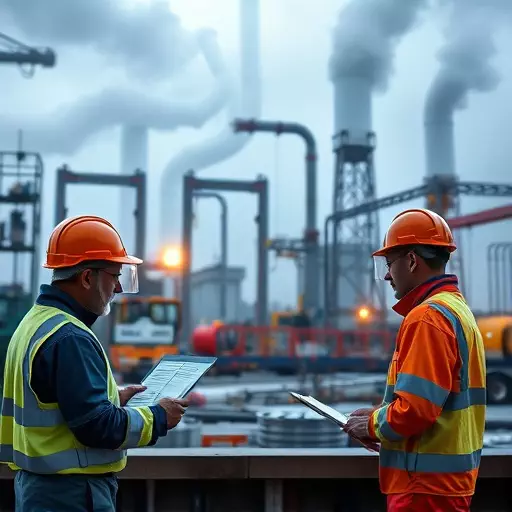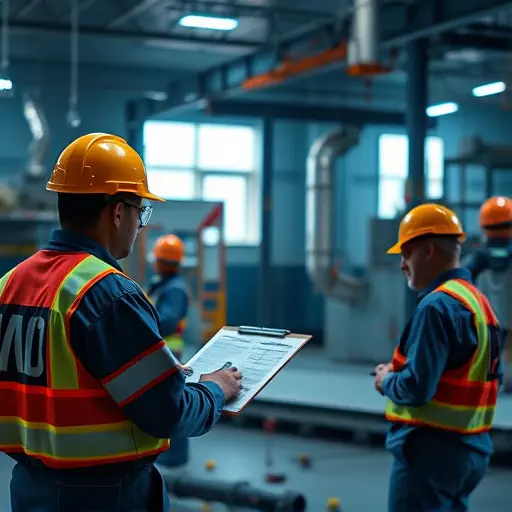In food manufacturing, adhering to stringent safety standards safeguards consumers and workers. Specialized safety training by industry equips employees with risk mitigation skills through hazard assessment techniques and safety training curriculum development. This proactive approach enhances product quality, ensures regulatory compliance, and fosters a culture of vigilance, minimizing accidents and incidents. Regular updates and interactive learning ensure staff preparedness for real-world scenarios.
In the dynamic landscape of food manufacturing, adhering to stringent safety standards is paramount. This comprehensive guide delves into the intricate world of food manufacturing safety, exploring key aspects that underpin a robust safety framework. From understanding foundational concepts to implementing cutting-edge hazard assessment techniques and developing tailored safety training curricula, each section unravels vital practices.
We dissect the pivotal role of specialized safety training in the industry, offering insights on effective curriculum design and continuous improvement strategies. Discover how these elements converge to ensure a culture of safety, keeping consumers protected and businesses thriving.
- Understanding Food Manufacturing Safety Standards: A Comprehensive Overview
- The Role of Specialized Safety Training in the Food Industry
- Hazard Assessment Techniques: Identifying and Mitigating Risks
- Curriculum Development for Effective Safety Training Programs
- Implementing and Maintaining Strict Safety Protocols in Food Production
- Continuous Improvement: Staying Updated with Evolving Safety Standards
Understanding Food Manufacturing Safety Standards: A Comprehensive Overview

In the dynamic landscape of food manufacturing, understanding and adhering to safety standards is paramount. These standards are designed to ensure the safety and quality of food products, protecting both consumers and workers. Specialized safety training by industry experts plays a crucial role in this process. It equips employees with the knowledge and skills needed to identify and mitigate potential risks, from proper handling techniques to emergency response protocols. Such training is tailored to address unique challenges within different manufacturing environments, fostering a culture of safety consciousness.
Complementing these efforts are robust hazard assessment techniques that serve as the backbone of comprehensive safety management. These methods involve systematic evaluations of production processes, equipment, and facilities to identify potential hazards at every stage. By employing advanced tools and methodologies, food manufacturers can proactively address risks, implement effective control measures, and continuously improve their safety performance. Furthermore, safety training curriculum development is a dynamic process that keeps pace with evolving industry standards and best practices, ensuring that training programs remain current and relevant.
The Role of Specialized Safety Training in the Food Industry

In the food manufacturing sector, ensuring safety is paramount to prevent contamination and maintain consumer trust. Specialized safety training by industry plays a pivotal role in achieving this goal. Tailored training programs equip workers with knowledge and skills to identify potential hazards using advanced hazard assessment techniques. These techniques go beyond basic food safety protocols, delving into process-specific risks and environmental factors that could lead to product tampering or spoilage.
Curriculum development for such training focuses on practical applications, scenario-based learning, and regular updates to keep pace with evolving regulations. By investing in comprehensive safety training, food manufacturers foster a culture of vigilance and accountability among their workforce. This proactive approach not only minimizes accidents and incidents but also enhances the overall quality and integrity of food products, ensuring they meet strict health and safety standards.
Hazard Assessment Techniques: Identifying and Mitigating Risks

In the dynamic landscape of food manufacturing, ensuring safety is paramount. Hazard Assessment Techniques (HATs) play a crucial role in this process by identifying potential risks and implementing effective mitigation strategies. Specialized safety training by industry experts is integral to equipping employees with the knowledge and skills needed to conduct thorough HATs. This involves curriculum development that aligns with current regulations and best practices, focusing on areas like hygiene, allergen control, and machinery safety.
A robust safety training curriculum should encompass various techniques such as Hazard Analysis and Critical Control Points (HACCP), which helps in pinpointing potential hazards at every stage of food production. Additionally, risk assessment matrices and qualitative/quantitative risk analysis methods enable a systematic evaluation of risks, allowing for data-driven decisions to enhance food safety. Regular training updates and simulations further reinforce these skills, ensuring that food manufacturing facilities maintain the highest standards of safety.
Curriculum Development for Effective Safety Training Programs

In the dynamic landscape of food manufacturing, ensuring worker safety through effective training is paramount. Curriculum development plays a crucial role in fostering specialized safety training tailored to industry-specific needs. By employing advanced hazard assessment techniques, training programs can identify and mitigate potential risks associated with food production processes. This involves meticulously studying every step of the manufacturing chain, from ingredient handling to packaging, to pinpoint areas requiring heightened safety measures.
A well-structured curriculum should incorporate interactive modules, case studies, and practical exercises that engage participants actively in learning. These methods not only enhance knowledge retention but also prepare employees to handle real-world scenarios confidently. Regular updates to the training curriculum are essential to keep pace with evolving industry standards and emerging safety protocols, ensuring that food manufacturing facilities maintain the highest levels of safety and quality.
Implementing and Maintaining Strict Safety Protocols in Food Production

Implementing and maintaining strict safety protocols in food production is paramount to ensuring consumer protection and fostering public trust. At the heart of this process lies specialized safety training by industry experts, designed to equip employees with the knowledge and skills necessary to identify and mitigate potential risks. This comprehensive training covers a range of topics, from basic food handling practices to advanced hazard assessment techniques.
The development of an effective safety training curriculum involves meticulous planning and content curation. It should incorporate interactive modules, real-world scenarios, and regular updates to keep pace with evolving industry standards and best practices. By fostering a culture of continuous learning, organizations can guarantee that their staff remains vigilant and adept at navigating the complex landscape of food manufacturing safety.
Continuous Improvement: Staying Updated with Evolving Safety Standards

In the dynamic landscape of food manufacturing, continuous improvement is not just a buzzword—it’s a necessity. Staying ahead of safety standards involves actively engaging with industry experts and embracing innovative practices. One key aspect is specialized safety training tailored to the unique challenges faced by food manufacturers. By investing in comprehensive programs, companies can ensure their staff are equipped with the latest knowledge and skills, fostering a culture of safety that extends beyond mere compliance.
Hazard assessment techniques play a pivotal role in this evolution. Regular, meticulous evaluations not only identify potential risks but also drive the development of effective risk mitigation strategies. This, coupled with continuous training, allows manufacturers to stay agile and adapt their practices as safety standards evolve. A well-rounded safety training curriculum, developed by industry experts and informed by current trends, is essential for maintaining a competitive edge while upholding stringent safety protocols.


